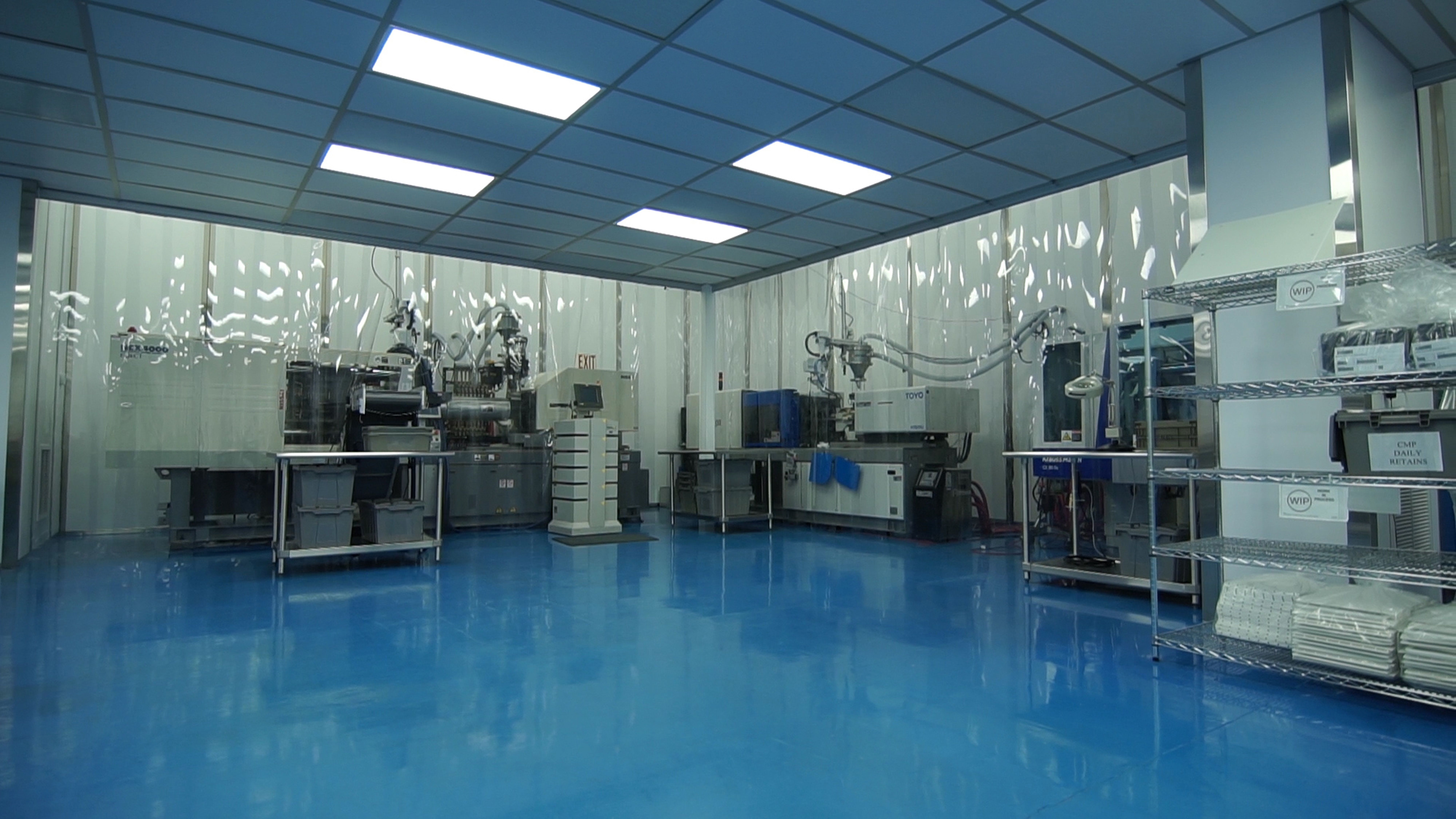When a plastic part is to be manufactured, e.g., an implantable medical device, it must be kept as clean as possible. Such a part must be manufactured in a sterile environment. That kind of environment may be referred to as a “cleanroom." A cleanroom is a space where the number of airborne contaminants per unit volume, such as dust and other airborne microbes, are controlled to decrease the chances of contamination. These particles are controlled by a High-Efficiency Particle Air (HEPA), which filters the air before entering the cleanroom, and is changed several times per hour, according to the cleanroom class, as established by the International Standard Organization (ISO) 14644-1.
Cleanrooms with the intention of keeping a product free of contaminants are kept at a positive pressure so that particles escape from the cleanest to the least clean area. However, there are cleanrooms that are kept under negative pressure to keep nothing out of the cleanroom, such as quarantine stations and chemical analysis facilities.
Plastic parts are manufactured in a dedicated room that is optimized to reduce the risk of contamination from dust or other particles. This process is known as cleanroom molding. In the medical, pharmaceutical, and biotechnology industries, parts often have to be manufactured in a sterile environment.
Before delving into cleanroom molding, it is important that you understand the difference that exists between an ISO 7 and an ISO 8 cleanroom.
ISO 7 and ISO 8 Cleanrooms for Plastic Injection Molding
ISO stands for International Standard Organization - this is made up of various organizations from different countries that work together to develop and publish standards. In this way, internationally valid standards are created that entrepreneurs must adhere to across borders.
The classifications of cleanrooms above are according to ISO 14644-1. The classification according to US FED STD 209E (cleanroom classes 1 - 100,000) is no longer valid since November 29, 2001; the cleanroom classes ISO 1 - ISO 9 has been in effect since then.
The standard ISO 14644-1 defines the degree of purity of the air. This is set by determining limit values. The ISO classification is based on the particle concentration per m³. The highest purity is in ISO class 1, while the lowest is classified in ISO class 9. This standard for cleanroom classes is mainly used in cleanroom systems that are used for production in the semiconductor industry
|
ISO classification number (N) |
The maximum value of the permissible concentrations (particles / m³) equal to or greater than the sizes considered, which are shown below |
||
|
|
> = 0.5 µm |
> = 1.0 µm |
> = 5.0 µm |
|
ISO 7 |
352, 000 |
83, 200 |
2, 930 |
|
ISO 8 |
3,520,000 |
832,000 |
29,300 |
Most plastic cleanroom injection molding takes place in a Class 7 or Class 8 cleanroom. If the plastic part has a very low resistance to impurities, such as used lenses in thermal imaging telescopes, it may require a more sterile environment.
ISO 7 cleanroom is a closed injection molding area, separate from the rest of the business district with hard walls. ISO 7 is mostly used for surgical interventions without implantation of foreign materials such as low invasive surgery, vascular, obstetrics, ophthalmology.
The standards for ISO 8 cleanrooms are less stringent than those for ISO 7 cleanrooms. In the ISO cleanroom, the store's molds are surrounded by movable curtains. ISO 8 is majorly used for short-term surgery such as visceral surgery, day surgery, and urology.
Environmental Control for Injection Molding in a Cleanroom
The required environment for ISO 7 and ISO 8 cleanrooms are environments with a lower degree of risk, such as general surgery, gynecology, patient preparation/awakening corridors, intensive care and resuscitation, etc. To ensure environmental control, several checks on the verification of instrument calibrations adjustment of the treatment system, airflow, air unidirectional check (where filtering plenum is present), noise and the smoke test should be carried out.
Points to consider in the required environment include:
Adequate airflow: To ensure that the air is pure and a tight number of particles are maintained, class 7 and 8 cleanrooms use positive airflow to ensure certain particles.
Use of Electric machines: Electric machines should be used instead of hydraulic engines in most cleanroom environments. This would prevent more airborne particles.
Coverage Requirements: In an ISO 7 cleaning room, engineers and operators must be fully covered when entering a cleanroom. Such coverings include shoe covers, full-body clothing and economical covers. In classroom 8, the coverage requirements may be more stringent.
Packaging Limits: Cardboard or coated plastic packages are common in a cleanroom environment. Packing, such as some corrugated board material capable of producing excess particles, is not allowed in cleanrooms.
Post-Molding Operations in a Cleanroom
In Cleanroom injection molding, the types of medical devices must be put into consideration. These medical devices are categorized into different classes. In addition, classification is risk-based, that is, the risk the device poses to the patient and/or the user is a major factor in the class it is assigned. Class I includes devices with the lowest risk, and Class III includes those with the greatest risk.
As indicated above, all classes of devices are subject to General Controls. General Controls are the baseline requirements of the Food and Drug Agency (FDA) Act that apply to all medical devices: Class I, II, and III.
The US FDA regulates all medical devices marketed in the US, which are grouped into three broad classes. Any medical device approved by the FDA is classified as Class I, II, or III depending on the device's risk, invasiveness, and impact on the patient's overall health.
Class I devices have minimal contact with patients and low impact on a patient's overall health. Examples of such devices includes electric toothbrush, tongue depressor, oxygen mask, reusable surgical scalpel, bandages, hospital beds, etc. Since this class of devices has the most minimal level of risk, they may not require a cleanroom injection molding.
Class II medical devices are more complicated than Class I devices and present a higher category of risk because they are more likely to come into sustained contact with a patient. Such devices include catheters, blood pressure cuffs, pregnancy test kits and syringes. These devices pose a greater risk, though they have medium complexity. For this reason, such devices can be sure to be safe and effective when more stringent regulatory controls are carried out. Most of these devices can be assembled or modeled in an ISO 8 cleanroom. Those whose manufacturing processes do not require a cleanroom include pregnancy testing kits and condoms.
The FDA defines Class III devices as products which “usually sustain or support life, are implanted or present a potential unreasonable risk of illness or injury." Such devices include breast implants, pacemakers, defibrillators, etc. Due to the nature of these devices, they carry the highest risk and are very complex. As a result of their complexity, all devices under this class have the most stringent regulatory controls and are normally assembled and molded in cleanrooms. The reason for this is to reduce the contamination rate from airborne particulate.
There are several plastic injection molding post-processing operations available to complete your project and reduce your supply chain.
Injection Molding in Cleanroom Applications
Cleanroom molding application can be done on a variety of medical devices. A good ISO 7 cleanroom can be used for packaging services and contract assembly. Custom fixtures are built, and automation is used to ensure that the assembly process for simple or complex operations is effective. Packaging services provided by the ISO 7 cleanroom cover various medical, pharmaceutical, and dental products.
An effective ISO 8 cleanroom is capable of housing different injection molding machines, which includes the vertical press. Such devices can be used to manufacture the following:
- Medical device housings
- Surgical instruments
- Implantables
- Emergency room products
- Fluid delivery devices
- Fluid delivery containers
- Cardiac products
- Blood delivery housings
Other products that can be manufactured include pediatric devices, medical imaging, dental products, and science and research devices.
Quality Control for Plastic Injection Molding
One of the procedures that qualify a cleanroom for the manufacturing of medical devices is obtaining the required certifications. Such certifications include the GMP, FDA, and ISO 13845:2016.
Good Manufacturing Practice (GMP) is a system that is responsible for ensuring that consistent manufacturing and control of products are in line with quality standards. This system is put in place to reduce any production-related risk and covers every aspect of the production process. Written procedures that are well detailed are required for each process, to ensure that the quality of the finished product is up to standard. Such measures will ensure that quality control is carried out during the cleanroom injection molding processes.
It is important that the cleanroom is in a controlled environment to ensure that plastics used in making these medical devices are not contaminated by dust and other particles. According to the Medical Device and Diagnostics Industry magazine, the Food and Drug Administration (FDA) requirements states that, in a case whereby product quality is affected by environmental conditions, “the manufacturer shall establish and maintain procedures to adequately control these environmental conditions.” To establish this control, cleanroom manufacturing is needed.
Just like the GMP, ISO 13485 is another system that is designed for an organization that deals with the production, servicing, and installation of medical devices. Some internal and external certification bodies also use this standard in their auditing processes. Every five years, all ISO standards undergo revision in order to keep up with the market place trend. The ISO 13485:2016 is the latest design that responds to the current quality control practices. Such practices include technological changes and regulatory expectations. This new version greatly emphasizes on changes that relate to the regulatory requirements, risk management and risk-based decision making.
Procedure Documentation
The regulation and maintenance of cleanroom certification, protocol, and accreditation for the injection molding of medical devices is highly comprehensive. Cleanroom injection molders must strictly adhere to a number of variables to ensure that they comply with the standards. Such variables include quality control systems that check, control, and eliminate dust and particles that do not align with the specification for ISO 7 and ISO 8 cleanroom standards.
For this reason, procedure documentation must be put in place. Procedure documentation should be carried out to ensure that verification of controlled conditions are always available in events of customer request, routine check, procedural deviation, or repeated cycles. Such procedure documentation should physically monitor the mold pull cycles, process lifecycle and product/equipment testing.
Risk Management for Plastic Injection Molding in Cleanrooms
Risk Management is carried out through the implementation of specific analysis modules like fault tree analysis (FTA), hazard analysis and critical control point (HACCP), and failure mode and effect analysis (FEMA). When microbial risks are known and evaluated, injection molders will be able to develop a continuous assessment to control contamination in the manufacturing process. In this way, injection molders will also be able to identify acceptable limits in the manufacturing process by plastic injection molding process monitoring.
Some FDA-regulated implantable medical products can lead to adverse and serious health effects when not monitored. For this reason, lot traceability is required in risk management. With a lot number, processes involved in the manufacturing process can be traced to ensure that risks are managed. Lot traceability monitors the ingredients, constituent parts, equipment, and labor, involved in the product manufacturing process. Consumers can also contact the manufacturer and research on the production of the goods through an identifier given by the use of lot traceability.
To understand the plastic injection molding process steps, types of injection molding processes, press tonnage calculator, and more - go to the Complete Guide to Plastic Injection Molding to get your project started down the right path.


